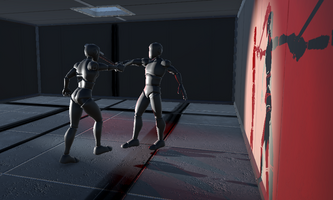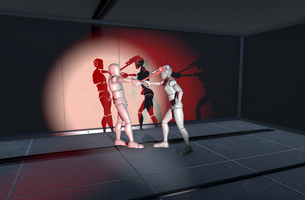Prototyping vs Building: Finding the Right Workflow


Asset Creation: The Solo Developer's Dilemma
I tried SketchUp today. It's incredibly easy to use, which is both good and bad. The problem is I don't know exactly what I want the base to look like yet. Until I have a clear vision, building custom geometry feels premature. Blender scares me a bit - not because it's hard, but because I could easily spend days building a single asset and lose all momentum on the actual game. I'm one person. I need to be smart about where I invest time.
At some point I'll need to make hard decisions about tooling: SketchUp vs Blender vs buying assets vs AI generation. Right now, I'm deferring that choice. Pope had a clear vision of the Obra Dinn from the start because ships have well-documented layouts. Antarctic stations are more varied. I need to prototype more before committing to an asset pipeline.
The Polar Asset Pack Reality Check
I bought a Unity Asset Store pack - a polar research station. I thought I'd done my research, knew it wasn't exactly like Halley VI station, but figured it was close enough. Then I actually used it in Unity. Seeing it "in the flesh" made me realize it's not quite what I want. The buildings are too generic, too videogame-y. I want something that feels like a real research station with claustrophobic corridors and authentic details.
Maybe I'll have to build my own environment from scratch. Or maybe I'm overthinking it and the asset pack is fine for prototyping. I briefly looked into AI-generated 3D assets but decided to table that for now. Too many unknowns, and I don't want to get distracted by shiny new tools before understanding the fundamentals.
First Death Scene Prototype: Success
I decided to stop overthinking and just build something. I created a simple room with two human character dummies in a death pose. One is lunging with a knife, the other is falling backward while swinging a huge wrench at the attacker's head. It took a few hours of playing around with Unity's transform tools, parenting objects to hand bones, and getting pivot points right.
I just realized the wrench pose might be unrealistic - can someone actually swing a heavy wrench one-handed while falling? This is the kind of detail I'll need to think about for believability. But for now, I'm happy I could assemble a frozen tableau in just a few hours. Added some dramatic spot lighting. It works. It reads clearly. That's the important thing.
The Critical Insight: Component-Based Clue System
This is the breakthrough I had today: I need to attach clue data directly to scene objects as Unity components. Each character in a death scene gets a component containing all their clue information - what they're wearing, what they're holding, visible injuries, position relative to others, anything the player could deduce from.
Then I export all this component data to CSV files, which feed into my external Python validation tool. This solves a massive problem: I can validate the mystery's solvability without manual playtesting. As I build scenes in Unity, the clue data automatically flows into the validator. If there's a logical gap - a character fate that can't be deduced - the validator catches it immediately.
This is directly inspired by Pope's workflow. He had custom tools that ensured every character fate in Obra Dinn was logically solvable. I'm building the same thing, but integrated with Unity from the start instead of as a separate spreadsheet. This should prevent the "rebuild everything when scaling" problem Pope faced.
Prototyping vs Building for Real
I'm in an awkward phase. Should I keep playing around to learn Unity's capabilities, or should I build as if this will go into the final game? Right now I'm leaning toward continued prototyping. I need to understand the limitations and possibilities before committing to architectural decisions. Pope spent years prototyping Obra Dinn before the "real" development began.
Better to waste a few weeks on throwaway prototypes than lock myself into the wrong approach early.
Next Task: Scene Navigation Menu
My next experiment is building a simple menu that lets me jump between different death scenes. This is just practice - learning how to make UI, how to teleport the player, how scenes load. Eventually the player will use the magic stopwatch to trigger these jumps, but for now I need the development tool version.
This connects to a larger question I haven't solved: how will the base layout work? In Obra Dinn, you walk around a ship and trigger memories at specific locations. I think I'll need one large interconnected base, with death scenes taking place in different rooms. But I haven't designed that base yet. I don't even know if I should.
Maybe each death scene should be its own isolated level that you teleport to, like a series of dioramas. Or maybe they need to exist in physical space for spatial deduction clues to work. I'm still figuring this out.
Design Decisions Still Pending
Asset Creation Strategy:
- Build custom in SketchUp/Blender?
- Kitbash from asset packs?
- AI generation?
- Hybrid approach?
Base Layout:
- One large interconnected station?
- Separate diorama levels?
- How does spatial reasoning factor into deductions?
Development Philosophy:
- Prototype extensively before committing?
- Or build "for real" now and iterate?
Visual Fidelity:
- Stick with low-poly simplicity?
- How much detail is necessary for clues to read clearly?
What I'm Learning
The more I prototype, the more I realize Pope's constraint-driven design philosophy makes sense. He chose a 1-bit aesthetic partly because it simplified asset creation. He chose a ship because the layout was well-defined. Every constraint made the project more manageable for one person.
I'm working without those constraints right now, which means I'm floundering a bit. I need to either embrace similar constraints (simpler art style, predefined base layout) or accept that I'll spend significant time on asset creation.
Key Takeaway
Prototyping is teaching me what's possible, but I can't prototype forever. At some point I need to make hard decisions about tools, art style, and scope. For now, I'm focusing on proving the core workflow: build scene → attach clue data → validate solvability. Once that loop works reliably, everything else will follow.
The component-based clue system feels like a genuine breakthrough. If I can export scene data to CSV automatically, the validator can run continuously as I build. That's the kind of infrastructure decision that matters more than whether I use SketchUp or Blender.
The Halley Incident
| Status | In development |
| Author | nfaug |
| Genre | Puzzle |
| Tags | Detective, Indie, Mystery, Story Rich |
More posts
- The Character Creation Mountain20 hours ago
- Prototyping the Frozen Fate System10 days ago
- Return of the Obra Dinn Meets The Thing: A Prototype22 days ago
Leave a comment
Log in with itch.io to leave a comment.